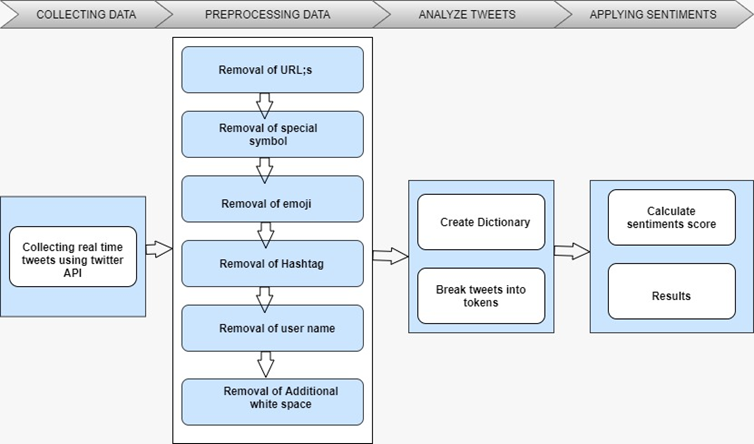Meme Detection of Journalists from Social Media by Using Data Mining Techniques
Keywords:
Meme Detection, Journalists, Social Media, Data Mining, Python, Sentiment AnalysisAbstract
With regard to today's social media networks, memes have become central character where millions of memes are shared per second on different social media networks. The detection of memes is a very concentrated and demanding subject in the current era. Today's social media (What's App, Twitter, and Facebook) is widespread around the world. People in all countries use these networks and spend their plentiful time on daily basis. As social media has an enormous amount of data overall in the world. Meme detection from media networks can be done by using their authenticated APIs. For this analysis we used some opinion mining techniques and sentiment analysis like statistical descriptive and content analysis. In our society, it is the better way to analyze about any journalist because social media can provide very huge amounts of data about any journalist however the authenticity is compromised, what is true or false, no one bother to check. Anyone can make approximate correct perceptions by using sentiment analysis and text mining techniques. It will provide highly wanted and hidden characteristics and perceptions for searchers and demanding people about journalists. Finally use for sentiment analysis by using Python.
References
A. Hellweg, “Social Media Sites of Politicians Influence Their Perception by Constituents,” J. Undergrad. Res. Commun., vol. 2, no. 1, pp. 22–36, 2011.
A. Pandey, S. Mukherjee, S. Bajaj, and A. Jonnalagadda, Identification of meme genre and its social impact, vol. 105. Springer Singapore, 2019.
L. Bing, K. C. C. Chan, and C. Ou, “Public sentiment analysis in twitter data for prediction of a company’s stock price movements,” Proc. - 11th IEEE Int. Conf. E-bus. Eng. ICEBE 2014 - Incl. 10th Work. Serv. Appl. Integr. Collab. SOAIC 2014 1st Work. E-Commerce Eng. ECE 2014, pp. 232–239, 2014, doi: 10.1109/ICEBE.2014.47.
G. Enli and C. A. Simonsen, “‘Social media logic’ meets professional norms: Twitter hashtags usage by journalists and politicians,” Inf. Commun. Soc., vol. 21, no. 8, pp. 1081–1096, 2018, doi: 10.1080/1369118X.2017.1301515.
M. Collins and A. Karami, “Social Media Analysis For Organizations: Us Northeastern Public And State Libraries Case Study,” pp. 1–6, 2018.
M. Bilal, H. Israr, M. Shahid, and A. Khan, “Sentiment classification of Roman-Urdu opinions using Naïve Bayesian, Decision Tree and KNN classification techniques,” J. King Saud Univ. - Comput. Inf. Sci., vol. 28, no. 3, pp. 330–344, 2016, doi: 10.1016/j.jksuci.2015.11.003.
M. Knight, “Journalism as usual: The use of social media as a newsgathering tool in the coverage of the Iranian elections in 2009,” J. Media Pract., vol. 13, no. 1, pp. 61–74, 2012, doi: 10.1386/jmpr.13.1.61_1.
C. Bauckhage, “Insights into Internet Memes,” Proc. Int. Conf. Weblogs Soc. Media, pp. 42–49, 2011.
S. He et al., “Massive meme identification and popularity analysis in geopolitics,” 2019 IEEE Int. Conf. Intell. Secur. Informatics, ISI 2019, no. 2017, pp. 116–121, 2019, doi: 10.1109/ISI.2019.8823294.
K. Amarouche, H. Benbrahim, and I. Kassou, “Product Opinion Mining for Competitive Intelligence,” Procedia Comput. Sci., vol. 73, no. Awict, pp. 358–365, 2015, doi: 10.1016/j.procs.2015.12.004.
N. A. Morton and Q. Hu, “Implications of the fit between organizational structure and ERP: A structural contingency theory perspective,” Int. J. Inf. Manage., vol. 28, no. 5, pp. 391–402, 2008, doi: 10.1016/j.ijinfomgt.2008.01.008.
L. Shifman, “Memes in a digital world: Reconciling with a conceptual troublemaker,” J. Comput. Commun., vol. 18, no. 3, pp. 362–377, 2013, doi: 10.1111/jcc4.12013.
W. Fan and M. D. Gordon, “The power of social media analytics,” Commun. ACM, vol. 57, no. 6, pp. 74–81, 2014, doi: 10.1145/2602574.
X. Deng and R. Chen, “Sentiment analysis based online restaurants fake reviews hype detection,” Lect. Notes Comput. Sci. (including Subser. Lect. Notes Artif. Intell. Lect. Notes Bioinformatics), vol. 8710 LNCS, pp. 1–10, 2014, doi: 10.1007/978-3-319-11119-3_1.
R. Boyle, “Sports Journalism: Changing journalism practice and digital media,” Digit. Journal., vol. 5, no. 5, pp. 493–495, 2017, doi: 10.1080/21670811.2017.1281603.
M. Crawford, T. M. Khoshgoftaar, and J. D. Prusa, “Reducing feature set explosion to facilitate real-world review spam detection,” Proc. 29th Int. Florida Artif. Intell. Res. Soc. Conf. FLAIRS 2016, pp. 304–309, 2016.
L. Xie, J. R. Kender, M. Hill, and J. R. Smith, “Xie et al - Visual memes is social media.pdf,” pp. 53–62, 2011.
N. Diakopoulos, M. Naaman, and F. Kivran-Swaine, “Diamonds in the rough: Social media visual analytics for journalistic inquiry,” VAST 10 - IEEE Conf. Vis. Anal. Sci. Technol. 2010, Proc., pp. 115–122, 2010, doi: 10.1109/VAST.2010.5652922.
P. B. Brandtzaeg, A. Følstad, and M. Á. Chaparro Domínguez, “How Journalists and Social Media Users Perceive Online Fact-Checking and Verification Services,” Journal. Pract., vol. 12, no. 9, pp. 1109–1129, 2018, doi: 10.1080/17512786.2017.1363657.
G. G. Chowdhury, “Natural language processing,” Annu. Rev. Inf. Sci. Technol., vol. 37, pp. 51–89, 2003, doi: 10.1002/aris.1440370103.
S. A. Eldridge, K. Hess, E. Tandoc, and O. Westlund, “Editorial: Digital Journalism (Studies)–Defining the Field,” Digit. Journal., vol. 7, no. 3, pp. 315–319, 2019, doi: 10.1080/21670811.2019.1587308.
M. Kim, L. Xie, and P. Christen, “Event diffusion patterns in social media,” ICWSM 2012 - Proc. 6th Int. AAAI Conf. Weblogs Soc. Media, pp. 178–185, 2012.
R. Barbado, O. Araque, and C. A. Iglesias, “A framework for fake review detection in online consumer electronics retailers,” Inf. Process. Manag., vol. 56, no. 4, pp. 1234–1244, 2019, doi: 10.1016/j.ipm.2019.03.002.
P. H. C. Guerra, D. Guedes, W. Meira, C. Hoepers, M. H. P. C. Chaves, and K. Steding-Jessen, “Spamming chains: A new way of understanding spammer behavior,” 6th Conf. Email Anti-Spam, CEAS 2009, 2009.

Published
How to Cite
Issue
Section
License
Copyright (c) 2022 50sea

This work is licensed under a Creative Commons Attribution 4.0 International License.




















